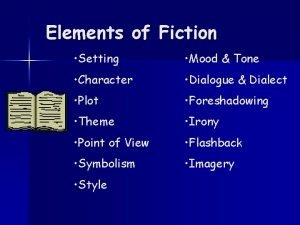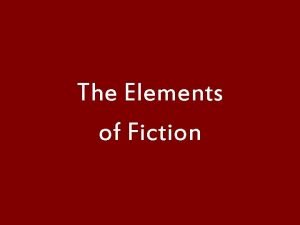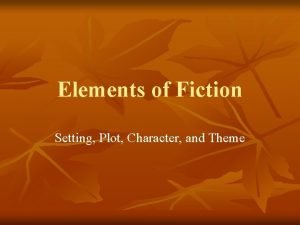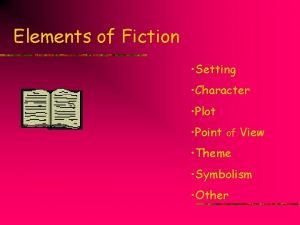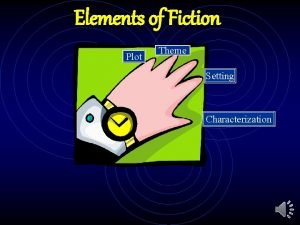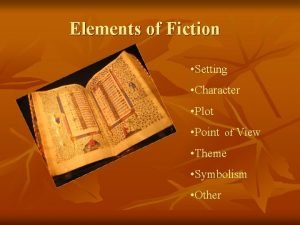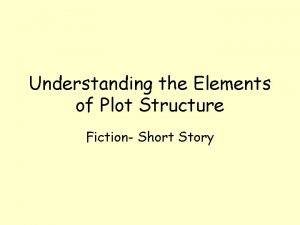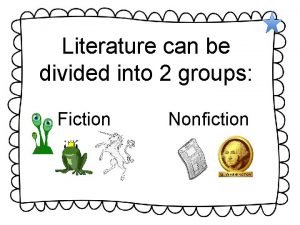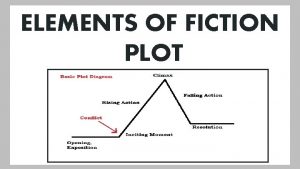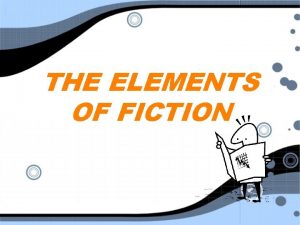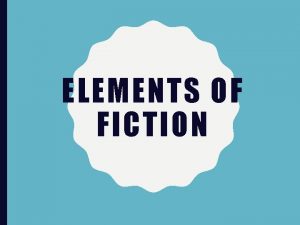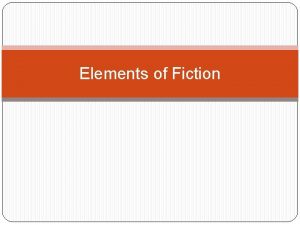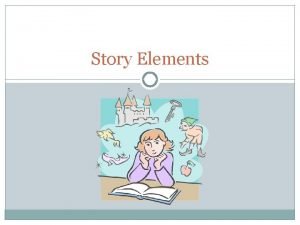Elements of Fiction The Main Elements Plot Setting











- Slides: 11

Elements of Fiction

The Main Elements • • Plot Setting Character Conflict Symbol Point of View Used by fiction writers to develop a story and its Theme.

Plot • Plot is the literary element that describes the structure of a story. • Shows the arrangement of events and actions within a story. – Exposition- Start of the story. Gives basic details the reader will need to know. – Rising Action- Series of conflicts and crisis leading up to the Climax – Climax- turning point. This is the most intense moment in the story. It can be emotionally intense or intense due to action going on. – Falling action- all of the action following the climax. – Resolution- conclusion or ending of the story. Loose threads are tied together.

Plot Diagram

Setting • Where the story takes place • Physical/Geographical- Place the story takes place, Ex: Mountain Home, Paris, Peru, etc • Time period- When in time the story takes place. Ex: WWII, Present, etc • Socio-Economic Characteristics- wealthy suburbs, city during the depression, etc • Specific places- Where exactly the story is set. Ex: A school house, a field, etc.

Character • The people (or animals or things, depending on the story) who appear in a story. – Round Characters- convincing and true to life. Have many personality traits – Flat Characters- stereotyped, shallow characters who only show one or two traits. Often are symbolic. – Dynamic Characters- undergo change and development throughout the story due to something happening to them or in their lives – Static Characters- do not change over the course of the story

Character • Protagonist- Main character in a story. Ex: Cinderella • Antagonist- Character opposing the protagonist. Ex: Cinderella’s stepmother • Direct characterization: the author develops the character through direct statements. Ex: Cinderella was beautiful and nice. • Indirect Characterization: Devoloping a character through their thoughts, what they say, comments made by other characters about them, and their physical appearance.

Conflict • Conflict is a struggle between two forces. • Two types: internal and external • Internal conflict: conflict within a person, with themselves. • External conflict: Conflict outside of a person. This can be a conflict with nature, with society or with a person

Symbol • Represents an idea, quality, or concept larger than itself. – A journey could symbolize life – Water could represent cleanliness and renewal – A lion could represent courage – A rose could represent love

Point of View • The perspective from which the story is being told. – Who is telling the story? – How do we know what is happening? • Different points of view: – Omniscient- Author is telling the story directly. Knows everything going on, and what each character is thinking. – Limited Omniscient/Third Person- Told from a character in the story. Knows all. – First Person- Told from a character’s point of view. Uses “I”

Theme • Central idea or message in the story. • Usually contains some insight into the human condition and life. • Can be stated directly or implied through the story’s actions and events.
 What is nonfiction
What is nonfiction Character tones
Character tones Elements of fiction setting
Elements of fiction setting Elements of fiction setting
Elements of fiction setting Elements of fiction setting
Elements of fiction setting Plot setting characterization
Plot setting characterization Element of fiction setting
Element of fiction setting Elements of fiction setting
Elements of fiction setting Plot structure of fiction
Plot structure of fiction It is genre of speculative fiction
It is genre of speculative fiction Contemporary realism literature
Contemporary realism literature Fiction and non fiction examples
Fiction and non fiction examples

